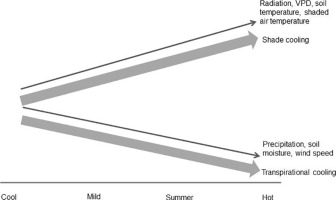Science of the Total Environment ( IF 8.2 ) Pub Date : 2018-03-21 , DOI: 10.1016/j.scitotenv.2018.03.168 Mohammad A. Rahman , Astrid Moser , Anna Gold , Thomas Rötzer , Stephan Pauleit

|
Moderation of thermal energy balance through the canopies of urban trees is well known. However, a more functional and quantitative view of the heterogeneous urban environment and their influence on the below-canopy vertical air temperature gradients is largely missing. Throughout the summer 2016 we continuously measured air temperature at three different heights (at 1.5, 3 and 4.5 m from the ground) under the canopies of two common but contrasting street tree species in respect of eco-physiology and morphology in Munich, Germany: Robinia pseudoacacia L. (ring porous) and Tilia cordata Mill. (diffuse porous). Along with air and surface temperature we also measured meteorological and edaphic variables and categorized summer time as cool, mild, summer and hot days. Global radiation, vapour pressure deficit and soil temperature increased as the days got warmer but precipitation, soil moisture and wind speed showed the reversed pattern. Overall, T. cordata trees with higher leaf area index and sap-wood area provided three times more transpiration than R. pseudoacacia. On an average air temperature gradient of outside to inside canopy dropped from 1.8 °C to 1.3 °C for T. cordata but from 1.5 °C to only 0.5 °C for R. pseudoacacia as the days got warmer. Vertical decline of air cooling effect was around 1 °C from canopy to the near-ground (1.5 m). Lower soil moisture but higher soil temperature suggested that cool air from the canopy mixed with a higher amount of sensible heat flux under the canopies of T. cordata compared to the R. pseudoacacia as the days got warmer. The study indicated a threshold for extreme hot days when grass surface evapotranspirational cooling will not be as effective and act like built surfaces rather deep shading from tree canopies will be important.
中文翻译:

在不同类型的夏季,两种对比城市树木的阴影下的垂直空气温度梯度
通过城市树木的树冠缓和热能平衡是众所周知的。但是,对于异类城市环境及其对冠层以下垂直空气温度梯度的影响,从功能上和数量上都没有更全面的了解。在2016年整个夏季,我们就生态和形态方面在德国慕尼黑的两种常见但截然相反的树种的树冠下连续测量了三个不同高度(距地面1.5、3和4.5 m)的空气温度:Robinia pseudoacacia L.(环状多孔)和紫ilia磨。(扩散多孔)。除空气和地表温度外,我们还测量了气象和水文变量,并将夏季时间分为凉爽,温和,夏季和炎热的几天。随着日间温度的升高,全球辐射,蒸气压赤字和土壤温度升高,但降水,土壤湿度和风速却呈现相反的趋势。总体而言,T.鱼腥草具有较高的叶面积指数和SAP木区的树木提供超过三次蒸腾刺槐。从总体上看,T。cordata的外层到内层的平均气温梯度从1.8°C降低到1.3°C,而R. pseudoacacia从1.5°C降低到仅0.5°C随着日子的变暖。从顶盖到近地面(1.5 m),空气冷却效果的垂直下降约为1°C。低土壤水分但较高的土壤温度建议从与的檐下较高量的显热通量的混合顶篷冷空气T.鱼腥草相比刺槐作为天获得温暖。研究表明,在极端炎热的天气时,草表面的蒸散降温将不那么有效,并且其作用不像建筑的表面,而树冠的深层阴影将很重要,因此这是一个阈值。











































 京公网安备 11010802027423号
京公网安备 11010802027423号